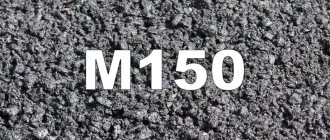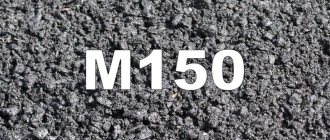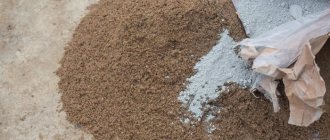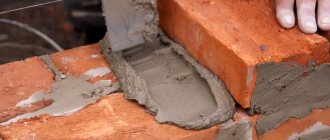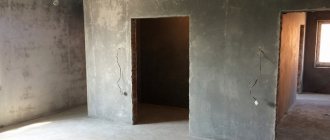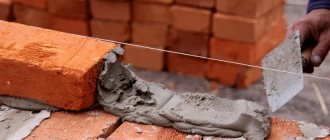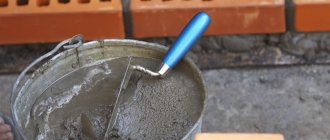Brick ovens somehow quickly gained their former popularity. There are more and more people who want to have this structure in their home. But the topic of today’s article affects the stoves themselves indirectly. We will be interested in the question of how to prepare a mortar for laying a stove.
Mortar for laying a brick stove Source remontik.org
Classification of furnace solutions
Firstly, we must immediately make a reservation that the construction of a furnace requires three types of masonry mortar. And that's the minimum. However, these solutions cannot be mixed like ordinary cement-sand ones.
The thing is that the stove consists of three structural elements: the foundation, the stove itself with a firebox, and the chimney. Now imagine that the foundation must withstand quite serious mechanical loads. And most often in winter its temperature is 0°. In the firebox the temperature reaches up to +1000C, and the chimney located outside is constantly exposed to low temperatures. Now it is clear that ordinary cement mortar will not withstand such varied loads.
Secondly, today the building materials market offers ready-made mixtures. It would seem very convenient. Add water according to instructions and apply. But let's look at the economic side of the issue.
Ready-made oven mixtures Source applesakhalin.ru
Laying one hundred bricks will require three buckets of mortar. And 100 standard brick blocks are not enough for half the cooking surface of a regular summer kitchen. Not to mention the foundation and chimney. That is, you will have to purchase a fairly large number of bags of dry mixture for ovens from the store. And the prices for this material are considerable. So think about how to prepare a solution for laying a clay stove without buying ready-made mixtures. It will cost many times less.
Understanding the terms
In the kiln business, three terms are used in relation to masonry mortars:
- Heat-resistant solution. This material can easily withstand heating to fairly high temperatures. And when cooled, it does not crack, does not deform, does not change its structure, and maintains a high design load-bearing capacity.
- Heat resistant. Such a solution can easily withstand dynamic loads in a heated state. It retains its mechanical characteristics during temperature changes. But the magnitude of thermal deformations is slightly lower than that of the heat-resistant version.
- Refractory. It absorbed all the characteristics of the two previous types. But at the same time, it easily tolerates the negative effects of chemically aggressive substances. This refers to waste carbon monoxide that passes through the firebox and chimney.
Now the question is what kind of mortar is needed for laying the stove. The answer is heat-resistant and fire-resistant.
Heat-resistant oven mixture for masonry Source catalogue.brick-concrete-concrete.rf
But as for the foundation, such a complex solution is not needed here. The thing is that this part of the structure is practically not subject to serious temperature fluctuations. After all, the foundation itself is a concrete monolithic structure on which two rows of bricks are laid. This is exactly what we are talking about. For their laying, ordinary cement-lime mortar is suitable. The main thing is to use red solid brick for masonry.
Now about the body of the furnace, or as it is called, the heat-storing part. In essence, this is a stove made of red solid brick of the M150 brand, inside of which there is a firebox. The latter folds separately, and more about it below.
So, in the heat-accumulating part of the structure, the heating of the bricks is small - up to +600C. But it is here that the bricks are exposed to intense exposure to carbon monoxide and acidic condensate. For masonry it is better to use ordinary clay mortar. Let’s immediately say that this mixture is simple in composition, the preparation method is specific. More about him below.
Next is the firebox, which is assembled from fireclay bricks. Here the temperature reaches +1200C, so a fire-resistant mortar is used for masonry - clay-clamotte.
Chimney mortar - lime Source i1.ytimg.com
Now the chimney consists of several parts:
- Source. Here the temperature does not rise above +400C, so the brick and mortar are exactly the same as in the heat-storing part of the furnace.
- Fluffing is a transition through the ceiling of a house. Temperatures in this part are low, but a certain structural strength is required. Therefore, for masonry we choose solid bricks and lime mortar.
- Chimney located in the attic and above the roof. High temperatures have no effect here. But there are special requirements for strength, especially for the external part. Because it is affected by wind loads. For construction you will need ordinary red brick and lime mortar.
- Pipe fluffing . Everything here is the same as in the previous paragraph.
Please note that each part uses its own brick and mortar. This is what allows you to save a lot on the purchase of building materials.
Materials and tools
So, what do we need to mix a good solution? First, the tools. With their help, we will knead, sow, lay... Secondly, we need the materials themselves, that is, what we will knead, sow and lay.
Tools: a shovel - for preparing sand and clay, a trowel - mix and use for work, a sieve with a mesh size of 1-2 mm, container (trough, bathtub, tank), a couple of basins, a bucket, a drill or a hammer drill with a mixer attachment.
Necessary materials: clay - the base of the solution, sand - the main filler, cement - the binding component, lime , asbestos , gypsum - auxiliary and additional components (usually not used), clean water .
A few words about fireclay
The question of what kind of solution the stoves are placed on involves one material that many consider to be a mineral. This is fireclay. We must immediately make a reservation that this is a mixture of high-alumina clay and several minerals: garnet, zirconium and others.
Fireclay is produced by deep firing of the prepared mixture. In this case, they burn even after complete removal of water from the mixture. The main task of the technology is to pelletize and sinter the components.
It is this material that is used in the process of making fireclay bricks, where the first one performs the functions of sand. For household stoves, bricks with a water absorption of 15-20% are suitable. As for solutions, here you can use fireclay in the form of a mortar - this is an unshaped mass. Or in the form of broken fireclay bricks, which are sold on the market as sand or crushed stone. Mortar is better.
Mortar is an unshaped mass of fireclay Source i.stroy-ka.ru
See also: Catalog of projects of houses with a stove for permanent residence
Properties of masonry mortars for furnaces
Before making a mortar for laying a stove, you need to understand that the properties and characteristics of the mixtures mentioned above determine their place of purpose in the stove structure. Therefore, more specifically about them:
- Clay. This is a cheap material that can cost you nothing if you find the right clay. But kneading it is a labor-intensive process. Here are the characteristics of the solution: strength and heat resistance are average - up to +1100C, fire resistance - absolute, maximum gas density. Can be used if the stove is built indoors.
- Lime. To prepare, you need to know one important nuance - you use lime that is slaked completely to the last grain. If this is not done, then there is a high probability that these grains will create conditions for the appearance of cracks in the masonry. And this reduces the quality of the seam. As for the characteristics, then: fire resistance and heat resistance are below average, strength is above clay. The solution is not hygroscopic, so it can be used for stoves built outdoors.
Clay mortar for the oven Source www.diy.ru
- Cement-lime. Used to lay the foundation of the stove. Strength is high, gas density is low.
- Clay-fireclay. Exactly the same characteristics as clay, but higher heat resistance - up to 1200C. Used in the construction of fireboxes.
- Cement-chamotte. This is the most expensive solution of all, because only high-quality materials must be added to it. As for the characteristics, there is a difference: strength is comparable to cement-lime, heat resistance is like clay-fireclay, fire resistance is sufficient for combustion chambers.
Let us immediately make a reservation that all these solutions are difficult to mix by hand.
What parameters are affected by the mixture for laying bricks?
A mixture of poor quality or inappropriate for operating conditions can cause very unpleasant consequences. The stove will either have to be constantly repaired, or completely redone taking into account the mistakes made.
The quality of the solution affects the safe operation of the furnace
How does a poor-quality masonry mixture manifest itself?
- Cracks in masonry joints. They are most quickly detected in places of maximum heating. The presence of cracks indicates that the strength of the furnace has decreased significantly.
- Smoke enters the room. A very dangerous phenomenon that requires immediate elimination. In winter, the stove is not dismantled; cracks have to be periodically sealed with mortar throughout the season. After a few days it falls out and the process needs to be repeated.
- The bricks are shaking. Such consequences are found near the firebox doors. Heavy cast iron structures are connected to bricks. If they are not strong enough, then the doors will wobble a lot when opening/closing. With such a problem, you can hold on to the heat, but you need to use the firebox very carefully and carefully.
If you use a low-quality solution, you will subsequently have to repair cracks in the slab
Video description
The video shows how to prepare a clay mortar for laying a stove:
What is gas density - this is a characteristic of a solution, which shows that dense gases from fuel combustion cannot pass through the thickness of the applied mixture by diffusion. It should be noted that gas density is not hygroscopicity. The thing is that water vapor is more mobile, so it easily passes through the material. Hence the concept of “breathable” structures. For example, a cement-sand mortar does not allow vapor to pass through when it dries. But carbon monoxide still passes through it. Therefore, it is very important that the solutions used in the construction of furnaces must be selected in accordance with both hygroscopicity and gas density.
How to choose the right components
How to make a mortar from clay for the stove so that it does not crack. It is clear that the quality of the final result always depends on the components of the mixture. Therefore, we will deal with each separately and outline some of the nuances of choice.
See also: Catalog of companies that specialize in installing stoves, fireplaces and equipping gazebos and grill houses
Clay
This is the main component. It is found in large quantities on any private plot. But here the question arises: is all the clay suitable for laying a stove? Moreover, when choosing this material in one place, you may encounter several of its types, arranged in layers. So what kind of clay is needed?
Fatty fireproof clay Source www.banikaminy.ru
Let us immediately make a reservation that all the above-described characteristics of solutions: strength, hygroscopicity, gas tightness, and so on, are determined by the properties of the clay. And the main property of the latter is fat content. Furnaces require material of medium fat content. Very oily clay cracks when dried, thin clay has low strength. For information, fat content is determined by the quantitative ratio of sand and two elements: silicon oxide and aluminum. Of course, organics also contribute their own characteristics.
Attention! If oily clay is found on the site, then it’s not a problem. It can be thinned by adding sand.
How to determine fat content. This can be done without laboratory tests. This will require a piece of material less than half the size of a fist. It must be kneaded with wet hands until it becomes plastic. Then the ball is placed between flat plates, for example, two planks or pieces of sheet iron. Pressure is created until the test sample cracks. Now the thickness of the resulting cake is measured. If this parameter has decreased by 1/3 of the diameter, then such clay can be used in kiln making.
And one moment. Not everything that comes across the site can be considered clay. There are so-called deception minerals that are very similar to clay. For example, bentonite, shale, marl and others.
Refractory heat-resistant cements
Refractory is a heat-resistant cement that belongs to aluminous or high-alumina materials. The solution prepared on its basis is characterized by an increased rate of hardening in water and air and is especially durable.
Features and Specifications
Refractory cement has the following characteristics:
- Heat resistance. Resistant to temperature increases up to 2000-3500°C.
- Strength. As the heating temperature increases, ceramic bonds are formed in the composition, giving special strength to the material. Also, the increase in this characteristic is influenced by the percentage of cement in the solution. The more it is, the stronger the mixture.
- Hardening speed. Record-breaking compared to others and making it possible to operate the resulting product after 20 hours.
- Adhesion and viscosity. According to these criteria, the refractory type of cement is in no way inferior to ordinary cement.
- Corrosion resistance. Thanks to the calcium aluminate used in the composition, the refractory solution is not subject to rapid decomposition and corrosion.
- Non-conductive properties. Due to the lack of moisture in the composition.
- Manufacturability of use. The proportions and methods of using this material are not much different from Portland cement.
- Simplicity of the cooking process. To make the solution you just need to mix cement, sand and water.
Refractory differs from other types of cement, for example, from slag or Portland cement, in the degree of resistance to elevated temperatures. Thus, almost any type is deformed at a temperature of 250°C, and at 500°C it cracks and bursts, which negatively affects the integrity of the structure. Refractory cement, even at 2000°C, retains its original properties.
Aluminous cement is produced in the GC-40, GC-50, GC-60 grades. Its main consumers are fuel and energy enterprises and defense construction complexes. The most common brands of high-alumina cement are VGTs-I-35, VGTs-75-05. They have increased fire resistance in comparison with GC-40 and GC-50 and do not emit an unpleasant odor during operation.
GC and VGC are made using alumina by smelting and, compared to Portland cement, are more fire-resistant, and when mixed with fillers such as magnesite or chromite ore, they can be used to produce hydraulically hardening mortars.
Unlike Portland cement, the hardening period of which is 1-3 days, refractory cement sets in no more than 10 hours. It hardens well in a humid environment, and when added to concrete makes it waterproof and frost-resistant. However, in order to avoid recrystallization, it needs to be provided with the necessary humidity during the day at the optimal temperature.
Refractory alumina cement has a higher density compared to other types. It is also more resistant to the negative influence of aggressive environments. However, heat-resistant cement is deformed when exposed to alkali, so mixing it with lime or gypsum is not recommended.
Scope of application
The refractory type is used for the manufacture of heat-resistant building mixtures used in the installation and repair of stoves, fireplaces and chimneys. Also, with the use of GC and VGC, cellular concrete, coatings, masonry mortars, bricks and blocks, which are particularly durable, are produced. Refractory mixtures for stoves and fireplaces have increased heat resistance and crack resistance.
Dry mixtures based on heat-resistant cement are successfully used for repair and restoration work when lining thermal units in various industrial sectors. Fireproof materials are also used in the creation of monolithic structures, special mortars and dry mixtures. They are practically indispensable for concrete work in the cold season, when they can be used without heating at temperatures down to -10°C, and for the production of non-shrinking materials. They are used both in ferrous and non-ferrous metallurgy (in smelting units for various metals).
Heat-resistant cement is used as an ingredient in the manufacture of mortars and adhesives in the construction chemical and oil refining industries. It is used in devices for the production of phosphorus, ammonia, and various alcohols. It is also suitable for the construction of mines, underground structures, and foundations for cars. The refractory mixture can also be used in the energy sector for the manufacture of burner stones, glass furnaces and other products of high strength.
Since the heat-resistant material has a short setting time compared to Portland cement, it can also be used for urgent home repairs. It is also used to prepare the base for floors, window sills and lintels.
In order to buy high-quality cement, you need to pay attention to the brand and the availability of product conformity certificates. Heat-resistant material, unlike regular material, has a higher price, since it is specialized. The table shows approximate prices for the most popular brands of refractory cement. The cost of the material may vary depending on the season (prices increase in summer, prices decrease in winter).
Video description
The video shows how you can determine the fat content of clay:
Sand
This building material is another component of masonry mortar for stoves. What sand can be used in this case:
- white quartz
- yellow , it consists of feldspar, suitable for all parts of the stove except the firebox.
If you buy sand on the market, then the best option is sifted sand of different fractions. It is this that creates the high strength of the masonry.
Now let's look at the question of how to make a mortar for the oven so that it does not crack, from clay and sand. To do this, you will have to conduct an experiment, for which you will need clay - 5 pieces. We add sand to four of them in different proportions: 25%, 50%, 75% and 100%. The solution must be mixed well. We leave one in the form of pure clay.
From these pieces, sausages of 30-40 cm are made, which are screwed, for example, onto the handle of a shovel. Then you need to wait until the samples dry. Sausages made from fatty clay do not crack, or only the top crust cracks. Samples made from lean material will crack completely, falling apart into pieces.
River sand for clay mortar Source www.diy.ru
Solution preparation technology
Which mortar for laying a stove is better - homogeneous. Therefore, it is very important to knead it correctly. Especially when the process is carried out using small-scale mechanization. The thing is that during the process of mechanical kneading, so-called gaps may appear inside the mixture. These are areas with a lot of clay milk. The latter will subsequently resolve, but the homogeneity of the material will be disrupted.
Some craftsmen beat clay. There is no need to do this for ovens. The main task is to strictly follow the technology. And it's simple:
- sifting components;
- mixing components;
- settling the resulting solution.
Kneading is usually done with shovels. Here it is important to carry out the operation until the mixture is completely homogeneous.
How to plaster a brick oven
So, having dealt with the question of what mortar is used for laying a brick oven, we move on to considering another position. Namely, what solution to cover the stove with so that it does not crack.
Firstly, you need to give time for the brick structure to shrink. Secondly, before starting plastering, the stove must be heated. The goal is to expand it in volume. Thirdly, a mesh is laid on the surface, which will strengthen the plaster layer. After which you can proceed to the main process.
The better to plaster. There are many options - these include ready-made mixtures and those prepared independently. The simplest is the clay mortar used for laying. Popular experience shows that it is necessary to add salt and wood ash to it. Two ingredients will not only increase the strength of the mixture, but also increase its heat resistance.
Plaster of a brick oven with a mesh attached to it Source avatars.mds.yandex.net
Before you prepare a solution from ash to putty the stove, you need to prepare all the ingredients. Here the ratio is:
- clay should be twice as much as sand;
- salt is added at the rate of 30 g per 1 liter of clay-sand mixture;
- ash at the rate of 50-60 g per 1 liter.
Practical tips for using the mixture
If you violate the generally accepted rules for laying stoves, then even with very high-quality mixtures you can get an outright defect. What do the professionals advise?
The quality of the furnace masonry depends not only on the mortar
- The clay should only be mixed with a special mixer; you can never achieve a homogeneous composition manually.
- The solution can be left for an unlimited amount of time. After drying, water is added and the composition is mixed. This cannot be done with cement-based solutions; once they harden, they cannot be corrected.
- Work is allowed only at temperatures not lower than +10°C. The bricks must be dry; the rate of moisture absorption does not affect the strength parameters.
- The first time the stove can be lightly heated no earlier than three days after the completion of the masonry. It is strictly not recommended to rush; if the recommendations are not followed, large cracks may appear through which smoke enters the room.
- To lay the outer row of the outer chimney, cement should be added to the mixture. Ordinary clay with sand is afraid of moisture and gradually erodes outdoors. Cement mortar does not react to the negative effects of natural precipitation.
For laying the chimney, use a solution containing cement.
Efflorescence may appear on poor-quality seams after the first fire, and white marks may be visible on the surface. This is a very unpleasant phenomenon and is removed over a long period of time. The efflorescence should be carefully scraped off, and then the surface should be trimmed with a damp cloth. Such actions will have to be repeated until the salts are completely eliminated.
How to remove efflorescence from the stove
The work of a stove maker requires not only theoretical and practical knowledge, but also great responsibility. This is one of the few construction works where no assistants are involved; all operations are performed by the master personally and bears full responsibility for the results of his work. Even a slight deviation from the recommended technologies becomes the cause of defects; to eliminate them, you need to lose a lot of time and financial resources.



